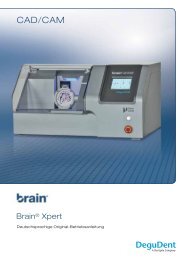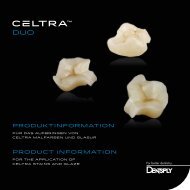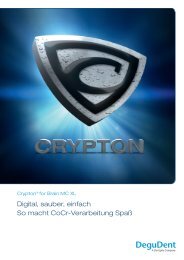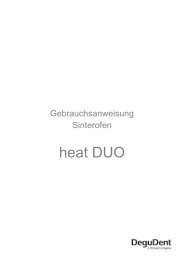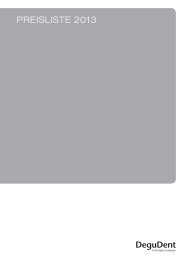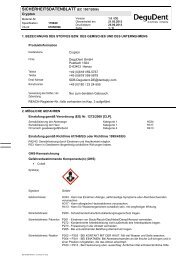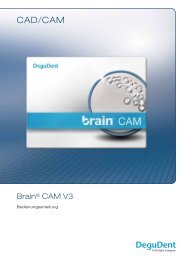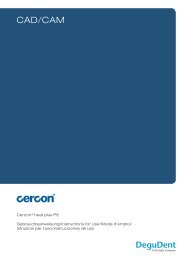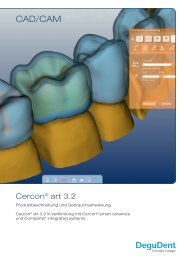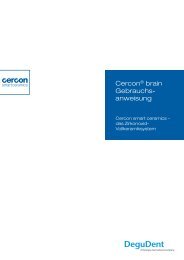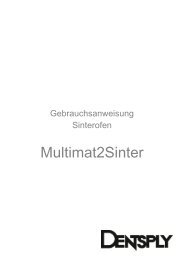Cergo® - DeguDent GmbH
Cergo® - DeguDent GmbH
Cergo® - DeguDent GmbH
You also want an ePaper? Increase the reach of your titles
YUMPU automatically turns print PDFs into web optimized ePapers that Google loves.
16 General notes on Cergo Kiss<br />
16|17 Processing notes<br />
18 General firing and pressing recommendations<br />
1. General notes on Cergo Kiss<br />
Purpose<br />
Pressable ceramic material for inlays, onlays, veneers and<br />
crowns. Cergo Kiss pressable ceramics can be excellently<br />
veneered with Duceragold Kiss veneering ceramics.<br />
Cergo Kiss is a component of the GoldenGate System.<br />
For dental use only.<br />
Contraindications<br />
Fabrication of bridgework<br />
Deep subgingival preparations<br />
Bruxism or other types of parafunction<br />
Technical Data<br />
Dental ceramic material: Type 2, Class 1 according to<br />
DIN EN ISO 6872<br />
Flexural strength and chemical solubility according to<br />
DIN EN ISO 6872<br />
Precautionary notes for medical products<br />
Adverse effects and interactions<br />
We are not aware of any risks or adverse effects related to<br />
Cergo Kiss pressable ceramics.<br />
If properly processed and used, adverse effects of these<br />
medical products will be highly unlikely. However, reactions<br />
of the immune system (such as allergies) or localized<br />
paraesthesia (such as an irritating taste or irritation of the<br />
oral mucosa) cannot be completely excluded in principle.<br />
Should you hear or be informed of any adverse effects –<br />
even when doubtful – we would like to request notification.<br />
In patient hypersensitivity to Cergo Kiss pressable ce -<br />
ramics or one of its ingredients, this medical product may<br />
not be used or only under the particular scrutiny of the<br />
dentist or physician in charge.<br />
Known cross-reactions or interactions of this medical<br />
product with other medical products or material already<br />
present in the oral environment must be taken into con -<br />
sideration by the dentist or physician in charge when<br />
selecting this medical product.<br />
Notify the dentist or physician in charge of all factors<br />
described above if you use this medical product for a<br />
custom construction. When working with these materials,<br />
make sure to comply with the Instructions for Use and the<br />
pertinent Material Safety Data Sheets (MSDS).<br />
2. Processing<br />
Die preparation (Figure 1)<br />
Establish the preparation margin.<br />
Use die hardener on the die.<br />
Apply die spacer on the dye.<br />
For veneers, inlays, onlays or crown frameworks.<br />
16<br />
Precautions<br />
Use only glass beads (2–4 bar), not aluminium oxide, for<br />
air-abrading the frameworks.<br />
Use water cooling when working with the pressable<br />
ceramics to avoid local overheating.<br />
Safety notes<br />
Do not inhale dust particles during grinding.<br />
Transport and storage<br />
Liquids: Store containers tightly closed at<br />
temperatures above 10°C.<br />
Protect powder from moisture.<br />
Symbols on product labels<br />
4 Product code<br />
5 Batch or lot number<br />
6 Use before<br />
7 Follow Instructions for Use<br />
8 Do not reuse<br />
1 10°C Lower temperature limit<br />
2 Keep dry<br />
Combinable liquids<br />
Dentine/incisal, etc.:<br />
Ducera ® Liquid SD<br />
Ducera ® Liquid Form<br />
Paints/glazes:<br />
Ducera ® Liquid Stain improved<br />
Adhesion<br />
Follow the manufacturer’s recommendations for<br />
composite.<br />
Cergo Kiss all-ceramic restorations cannot be temporarily<br />
cemented and then worn in situ. Cergo Kiss must be<br />
adhesively attached.<br />
In order not to compromise the quality of the definitive<br />
cementing, temporaries should only be cemented using<br />
non-eugenol cements.<br />
Release date: April 2005<br />
Wax modellation (Figure 2)<br />
Use only wax materials that burn out without residue.<br />
Use Isolit isolating liquid.<br />
For all restorative geometries, the wax modellation must<br />
have a minimum thickness of 0.7 mm (maximum wall



